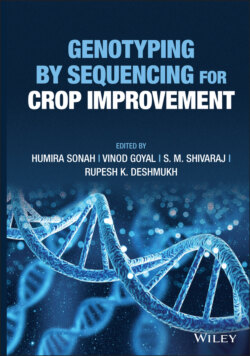Читать книгу Genotyping by Sequencing for Crop Improvement - Группа авторов - Страница 64
3.3.4 Chickpea
ОглавлениеCicer arietinum is the best source for protein, β‐carotene, and minerals such as iron, calcium, phosphorus, manganese, and zinc. Major abiotic stresses such as heat and drought can cause up to 70% loss in yield. Varshney and his coworkers utilize NGS technology to explore the germplasm wealth present in gene banks and provide information on genetic variation, domestication, and population structure of the 429 chickpea lines. They analyzed the 2.7 Tbp (terabase pair) raw data including 28.36 billion reads with around 6 Gbp (gigabase pairs) raw data per sample. By using mapped resequencing data, they reported a map of 4.97 million SNPs, 596 100 indels, 4931 CNVs, and 60 742 PAVs (presence–absence variation) in 429 reference genotypes set. Out of 4.97, million the most of the SNPs (i.e. 85%) were found in intergenic regions and around 4% were present in coding sequences. They identified 107 375 heterozygous and 20 544 homozygous SNPs by using SNP calling procedure. Genome‐wide association provides all the resources and generates new avenues for chickpea breeding in the future (Varshney et al. 2019).
